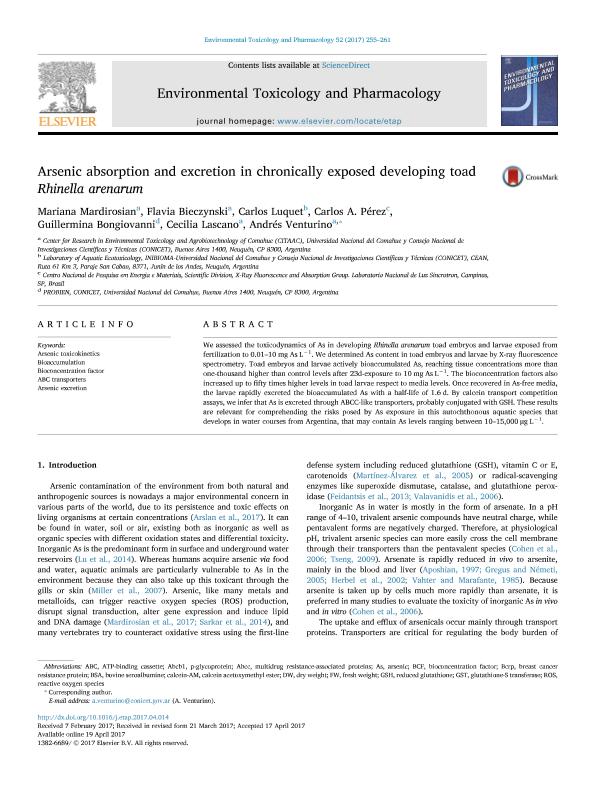Mostrar el registro sencillo del ítem
dc.contributor.author
Mardirosian, Mariana Noelia

dc.contributor.author
Ceschin, Danilo Guillermo

dc.contributor.author
Lascano, Cecilia Ines

dc.contributor.author
Venturino, Andres

dc.date.available
2018-09-06T15:30:38Z
dc.date.issued
2017-02
dc.identifier.citation
Mardirosian, Mariana Noelia; Ceschin, Danilo Guillermo; Lascano, Cecilia Ines; Venturino, Andres; Molecular effectors in the chronic exposure to arsenic as early and sensitive biomarkers in developing Rhinella arenarum toads; Elsevier Science; Aquatic Toxicology; 186; 2-2017; 19-27
dc.identifier.issn
0166-445X
dc.identifier.uri
http://hdl.handle.net/11336/58521
dc.description.abstract
Arsenic, a natural element of ecological relevance, is one of the most toxic elements present in various regions of the world. It can be found in natural water sources throughout Argentina in concentrations between 0.01 and 15 mg L–1. The Argentinean autochthonous toad Rhinella arenarum was selected to study the molecular mechanisms involved in the effects and response to the chronic As exposure along its embryonic and larval development. We evaluated the effects on MAPK signal transduction pathway and transcription factors c-FOS and c-JUN, and the regulation of the expression at protein levels of different antioxidant enzymes. Our results indicated that As is modulating the MAPK pathway, increasing MEK and ERK levels both in the nuclear and post-nuclear fraction along the embryonic development and mainly at the beginning of the larval stage. Through this pathway, As can upregulate transcription factors like c-FOS and c-JUN, impacting the antioxidant response of the exposed embryos and larvae through antioxidant enzymes and recycling of GSH. Arsenic triggered specifically the synthesis of antioxidant enzymes in exposed R. arenarum embryo and larvae. In particular, the expression levels of SOD, CAT and GST enzymes analyzed by Western blot showed a similar behavior to their enzymatic activities in our previous work. This fact suggests that not only the synthesis of these antioxidant enzymes but also their rapid degradation after inactivation would be regulated in response to ROS levels. Antioxidant enzymes may show dual responses of induction and inactivation followed by degradation depending on the levels of oxidative stress and impact on ROS targets when the exposure is sustained in time and intensity. We also performed a probability of exceedence analysis including our previous results to visualize a progression of the response in time and also established the best early-responding biomarkers at the lowest As concentrations. As a conclusion, the molecular biomarkers such as the MAPKs MEK and ERK and transcription factors c-FOS and c-JUN are early induced in the response of developing toad embryos exposed to very low As concentrations in water. The advantage of counting with molecular biomarkers early responding to low concentrations of As in a chronic exposure is that they may anticipate the irreversible damage at later developmental stages due to the constant oxidative challenge.
dc.format
application/pdf
dc.language.iso
eng
dc.publisher
Elsevier Science

dc.rights
info:eu-repo/semantics/openAccess
dc.rights.uri
https://creativecommons.org/licenses/by-nc-sa/2.5/ar/
dc.subject
Amphibians
dc.subject
Glutathione S-Transferase
dc.subject
Mapk
dc.subject
Molecular Biomarkers
dc.subject
Oxidative Stress
dc.subject
Transcription Factors
dc.subject.classification
Otras Ciencias Biológicas

dc.subject.classification
Ciencias Biológicas

dc.subject.classification
CIENCIAS NATURALES Y EXACTAS

dc.subject.classification
Otras Ciencias Biológicas

dc.subject.classification
Ciencias Biológicas

dc.subject.classification
CIENCIAS NATURALES Y EXACTAS

dc.title
Molecular effectors in the chronic exposure to arsenic as early and sensitive biomarkers in developing Rhinella arenarum toads
dc.type
info:eu-repo/semantics/article
dc.type
info:ar-repo/semantics/artículo
dc.type
info:eu-repo/semantics/publishedVersion
dc.date.updated
2018-08-31T14:07:02Z
dc.journal.volume
186
dc.journal.pagination
19-27
dc.journal.pais
Países Bajos

dc.journal.ciudad
Amsterdam
dc.description.fil
Fil: Mardirosian, Mariana Noelia. Consejo Nacional de Investigaciones Científicas y Técnicas. Centro Científico Tecnológico Conicet - Patagonia Norte. Instituto Andino Patagónico de Tecnologías Biológicas y Geoambientales. Universidad Nacional del Comahue. Instituto Andino Patagónico de Tecnologías Biológicas y Geoambientales.; Argentina
dc.description.fil
Fil: Ceschin, Danilo Guillermo. Consejo Nacional de Investigaciones Científicas y Técnicas. Centro Científico Tecnológico Conicet - Patagonia Norte. Instituto Andino Patagónico de Tecnologías Biológicas y Geoambientales. Universidad Nacional del Comahue. Instituto Andino Patagónico de Tecnologías Biológicas y Geoambientales.; Argentina
dc.description.fil
Fil: Lascano, Cecilia Ines. Consejo Nacional de Investigaciones Científicas y Técnicas. Centro Científico Tecnológico Conicet - Patagonia Norte. Instituto Andino Patagónico de Tecnologías Biológicas y Geoambientales. Universidad Nacional del Comahue. Instituto Andino Patagónico de Tecnologías Biológicas y Geoambientales.; Argentina
dc.description.fil
Fil: Venturino, Andres. Consejo Nacional de Investigaciones Científicas y Técnicas. Centro Científico Tecnológico Conicet - Patagonia Norte. Instituto Andino Patagónico de Tecnologías Biológicas y Geoambientales. Universidad Nacional del Comahue. Instituto Andino Patagónico de Tecnologías Biológicas y Geoambientales.; Argentina
dc.journal.title
Aquatic Toxicology

dc.relation.alternativeid
info:eu-repo/semantics/altIdentifier/doi/https://dx.doi.org/10.1016/j.aquatox.2017.02.019
dc.relation.alternativeid
info:eu-repo/semantics/altIdentifier/url/https://www.sciencedirect.com/science/article/pii/S0166445X17300504
Archivos asociados
